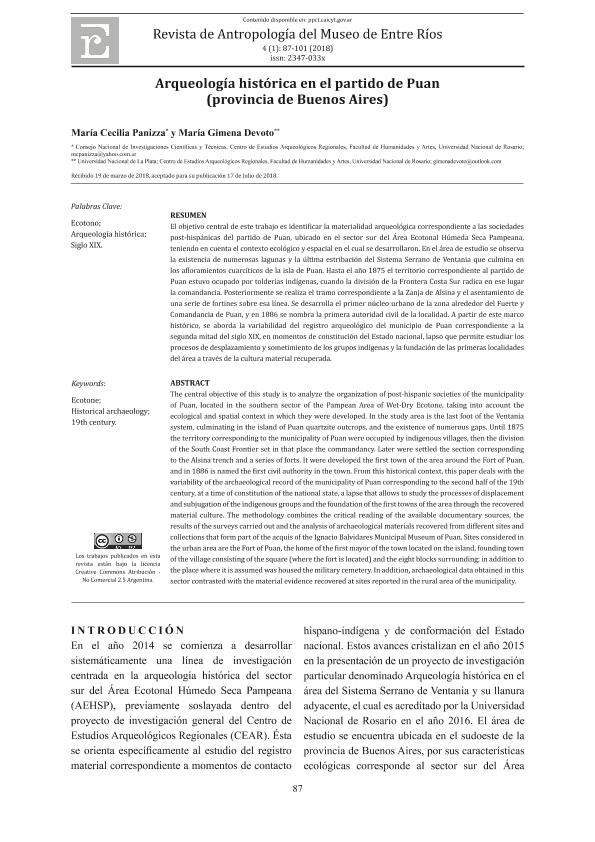Mostrar el registro sencillo del ítem
dc.contributor.author
Panizza, María Cecilia

dc.contributor.author
Devoto, María Gimena

dc.date.available
2020-05-07T20:47:18Z
dc.date.issued
2018-11
dc.identifier.citation
Panizza, María Cecilia; Devoto, María Gimena; Arqueología histórica en el partido de Puan (provincia de Buenos Aires); Museo de Ciencias Naturales y Antropológicas "Prof. Antonio Serrano"; Revista de Antropología del Museo de Entre Ríos; 4; 1; 11-2018; 87-101
dc.identifier.issn
2347-033x
dc.identifier.uri
http://hdl.handle.net/11336/104566
dc.description.abstract
El objetivo central de este trabajo es identificar la materialidad arqueológica correspondiente a las sociedades post-hispánicas del partido de Puan, ubicado en el sector sur del Área Ecotonal Húmeda Seca Pampeana, teniendo en cuenta el contexto ecológico y espacial en el cual se desarrollaron. En el área de estudio se observa la existencia de numerosas lagunas y la última estribación del Sistema Serrano de Ventania que culmina en los afloramientos cuarcíticos de la isla de Puan. Hasta el año 1875 el territorio correspondiente al partido de Puan estuvo ocupado por tolderías indígenas, cuando la división de la Frontera Costa Sur radica en ese lugar la comandancia. Posteriormente se realiza el tramo correspondiente a la Zanja de Alsina y el asentamiento de una serie de fortines sobre esa línea. Se desarrolla el primer núcleo urbano de la zona alrededor del Fuerte y Comandancia de Puan, y en 1886 se nombra la primera autoridad civil de la localidad. A partir de este marco histórico, se aborda la variabilidad del registro arqueológico del municipio de Puan correspondiente a la segunda mitad del siglo XIX, en momentos de constitución del estado nacional, lapso que permite estudiar los procesos de desplazamiento y sometimiento de los grupos indígenas y la fundación de las primeras localidades del área a través de la cultura material recuperada.
dc.description.abstract
The central objective of this study is to analyze the organization of post-hispanic societies of the municipality of Puan, located in the southern sector of the Pampean Area of Wet-Dry Ecotone, taking into account the ecological and spatial context in which they were developed. In the study area is the last foot of the Ventania system, culminating in the island of Puan quartzite outcrops, and the existence of numerous gaps. Until 1875 the territory corresponding to the municipality of Puan were occupied by indigenous villages, then the division of the South Coast Frontier set in that place the commandancy. Later were settled the section corresponding to the Alsina trench and a series of forts. It were developed the first town of the area around the Fort of Puan, and in 1886 is named the first civil authority in the town. From this historical context, this paper deals with the variability of the archaeological record of the municipality of Puan corresponding to the second half of the 19th century, at a time of constitution of the national state, a lapse that allows to study the processes of displacement and subjugation of the indigenous groups and the foundation of the first towns of the area through the recovered material culture. The methodology combines the critical reading of the available documentary sources, the results of the surveys carried out and the analysis of archaeological materials recovered from different sites and collections that form part of the acquis of the Ignacio Balvidares Municipal Museum of Puan. Sites considered in the urban area are the Fort of Puan, the home of the first mayor of the town located on the island, founding town of the village consisting of the square (where the fort is located) and the eight blocks surrounding; in addition to the place where it is assumed was housed the military cemetery. In addition, archaeological data obtained in this sector contrasted with the material evidence recovered at sites reported in the rural area of the municipality.
dc.format
application/pdf
dc.language.iso
spa
dc.publisher
Museo de Ciencias Naturales y Antropológicas "Prof. Antonio Serrano"
dc.rights
info:eu-repo/semantics/openAccess
dc.rights.uri
https://creativecommons.org/licenses/by-nc/2.5/ar/
dc.subject
ARQUEOLOGÍA HISTÓRICA
dc.subject
ECOTONO
dc.subject
SIGLO XIX
dc.subject.classification
Arqueología

dc.subject.classification
Historia y Arqueología

dc.subject.classification
HUMANIDADES

dc.title
Arqueología histórica en el partido de Puan (provincia de Buenos Aires)
dc.type
info:eu-repo/semantics/article
dc.type
info:ar-repo/semantics/artículo
dc.type
info:eu-repo/semantics/publishedVersion
dc.date.updated
2020-04-02T14:12:37Z
dc.journal.volume
4
dc.journal.number
1
dc.journal.pagination
87-101
dc.journal.pais
Argentina

dc.journal.ciudad
Paraná
dc.description.fil
Fil: Panizza, María Cecilia. Consejo Nacional de Investigaciones Científicas y Técnicas. Centro Científico Tecnológico Conicet - Rosario; Argentina. Universidad Nacional de Rosario. Facultad de Humanidades y Artes; Argentina
dc.description.fil
Fil: Devoto, María Gimena. Universidad Nacional de Rosario. Facultad de Humanidades y Artes; Argentina. Consejo Nacional de Investigaciones Científicas y Técnicas. Centro Científico Tecnológico Conicet - Rosario; Argentina. Universidad Nacional de La Plata; Argentina
dc.journal.title
Revista de Antropología del Museo de Entre Ríos
dc.relation.alternativeid
info:eu-repo/semantics/altIdentifier/url/http://ppct.caicyt.gov.ar/index.php/antropmuser/article/view/12607
Archivos asociados
